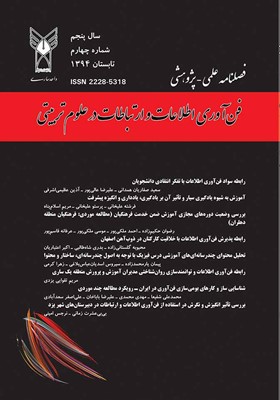رابطه پذیرش فنآوری اطلاعات با خلاقیت کارکنان در ذوبآهن اصفهان
محورهای موضوعی :
فن‎آوری اطلاعات
محبوبه گلستانی زاده
1
,
بدری شاه طالبی
2
,
اکبر اعتباریان
3
1 - کارشناس ارشد سیستمهای اطلاعات مدیریت، دانشگاه آزاد اسلامی واحد خوراسگان، اصفهان، ایران
2 - استادیار گروه مدیریت، دانشگاه آزاد اسلامی واحد خوراسگان، اصفهان، ایران
3 - استادیار گروه مدیریت، دانشگاه آزاد اسلامی واحد خوراسگان، اصفهان، ایران
تاریخ دریافت : 1393/06/24
تاریخ پذیرش : 1393/08/13
تاریخ انتشار : 1394/05/10
کلید واژه:
سودمندی درک شده,
پذیرش فنآوری اطلاعات,
خلاقیت کارکنان,
متغیرهای بیرونی,
چکیده مقاله :
پژوهش حاضر با هدف تعیین رابطه بین پذیرش فنآوری اطلاعات با خلاقیت کارکنان در ذوب آهن اصفهان به روش توصیفی از نوع همبستگی انجام شد. جامعه آماری را کلیه کارکنان بخش اداری این شرکت به تعداد 800 نفر تشکیل میدهد. با استفاده از فرمول حجم نمونه کوکران و به روش نمونهگیری در دسترس، تعداد 259 نفر بهعنوان نمونه آماری انتخاب گردیدند. ابزار جمعآوری اطلاعات، دو پرسشنامه شامل پرسشنامه محققساخته پذیرش فنآوری اطلاعات با استفاده از ابعاد مدل دیویس و پرسشنامه تعدیل یافته خلاقیت سازمانی رندسیپ بود، که روایی و پایایی آنها مورد تأیید قرار گرفت. یافتههای پژوهش حاکی از آن بود که بین ابعاد پذیرش فنآوری اطلاعات با خلاقیت کارکنان رابطه معنادار (577/0=r و 0/01>P) وجود دارد. نتایج حاصل از رگرسیون گام به گام نشان داد که از بین ابعاد پذیرش فنآوری اطلاعات در گام اول بعد متغیرهای بیرونی و در گام دوم بعد سودمندی درک شده بهترین پیشبینی کننده خلاقیت کارکنان بوده است.
چکیده انگلیسی:
The present research analyzed the relationship between acceptance of information technology and employees’ creativity in Isfahan Steel Mill Company using descriptive correlational approach. Statistical population was all 800 employees in administrative sections of the company. 259 people were chosen as the study sample using convenience sampling method and Cochran's sample size formula. To collect data, two researcher-made questionnaires of acceptance of information technology by using the dimensions of Davis Model (1989) and the adjusted questionnaire of Randcip’s organizational creativity (1979) were used. Also, the content validity and reliability were estimated and confirmed. The results showed that there was a significant relationship between acceptance of information technology and employees’ creativity (r =0.577, P <0.01). According to stepwise regression conducted, among the variables of acceptance of information technology, the best predictor of employees’ creativity in the first step was external variables and in the second step was perceived usefulness.
منابع و مأخذ:
Aghaei, M., & Zarandi Khaledi, M. (2011). Intangible capital sociology of organizations of the third millennium (1th Edition). Tehran: Jamae Shenasan Publication. (in Persian).
Bahram Zadeh, M. M., & Jafar Poor, M. (2011). Acceptance of information technology and user behavior (1th Edition). Tehran: Pelk Publication. (in Persian).
Fathian, M., & Mahdavi Noor, H. (2013). Fundamentals and management of information technology (1th Edition). Tehran: Iran University of Science and Technology. (in Persian).
Farhadi, R. (2011). ICT principles and applications (1th Edition). Tehran: Ketabdar. (in Persian).
Giraldo, T. R. (2011). Understanding the role of technology in service innovation: A theoretical overview. M.Sc. Thesis, University of Industrial Engineering and Management Industrial Management Stockholm, Sweden.
Heidari, Z., Orof Zadeh, Sh., & Dadkhah, R. (2011). Relationship with the creative use of information technology components of the physical education department staff in the province. National Congress of Students of Physical Education and Sports Sciences, Tehran, 15-16 December. (in Persian).
Johnson, A. M. (2005). The technology acceptance model and the decision to invest in information security. Proceedings of the 2005 Southern Association of Information System Conference, 114-118.
Kaewchur, O., & Phusavat, K. (2013). Mediating role of knowledge sharing on information technology and innovation. Proceedings of 2013 International Conference on Technology Innovation and Industrial Management. Phuket, Thailand, May 29-31, 179-188.
Karadal, H., & Saygin, M. (2011). The effect of information technology on innovation abilities: A research on smes. Proceedings of 2011 International Conference on Eurasian Economies, 396-399.
Korki, H., & Sanaei Zadeh, M. (2012). Creativity and learning strategies (1th Edition). Tehran: Aeizh. (in Persian).
Laudon, K., & Laudon, J. (2013). Management information systems (Translated by Mostafavi, S. A., and Hosseini, S. M.) (4th Edition). Tehran: Esatis Fadak Publication. (in Persian).
Mohammadi, N. (2006). Creativity and innovation (Definitions, concepts and management). Citizen Newspaper, 3730, 10. (in Persian).
Mohammadi, D., Mohammadi, Y., & Mohammad, A. M. (2012). Comprehensive approach to manage information systems (1th Edition). Tehran: Barayand Pooyesh Publication. (in Persian).
Moghimi, M., & Ramazan, M. (2013). A research management (Strategic management and entrepreneurship), Vol 11 (2th Edition). Tehran: Industrial Management Publication. (in Persian).
Nami, K., & Jabari Zaheer Abadi, A. (2011). Relationship between the use of ICT and creativity of staff at the faculty of psychology and educational sciences at Tehran University. National Conference on Education in 1404, Tehran. (in Persian).
Namamiyan, F., & Galiliyans, Kh. (2011). Effects on the concepts of information technology and information systems. Monthly Era of Information Technology, 70, 123-128. (in Persian).
Parkan, H., (2012). Fostering creativity in organizations with a view to Islamic texts (1th Edition). Qom: Institute of seminary and university. (in Persian).
Vahedi, M., & Rahbari, H. (2013). The Relationship between information technology and innovation in the company's stock brokerage based in East Azerbaijan. The First Meeting of the Director of Research, Development and Technology, Tehran, February 16-17. (in Persian)
Wu, J. H., & Wang, S. C. (2005). What drives mobile commerce? An empirical evaluation of the revised technology acceptance model. Information and Management, 42(5), 719-729.
Zohreh Dehdashti, Sh., Abdollahi, H., & Mohammad Pour Doost Kouhi, M. (2010). Identify and classify the elements of innovation in the organization based on organizational design categories. Journal of Human Resources, 12, 41-48. (in Persian).
Ackoff, R. (1996). Interactive planning (Translated by Khalili Shoorini, S.) (1th Edition). Tehran: Markaz Publication.


